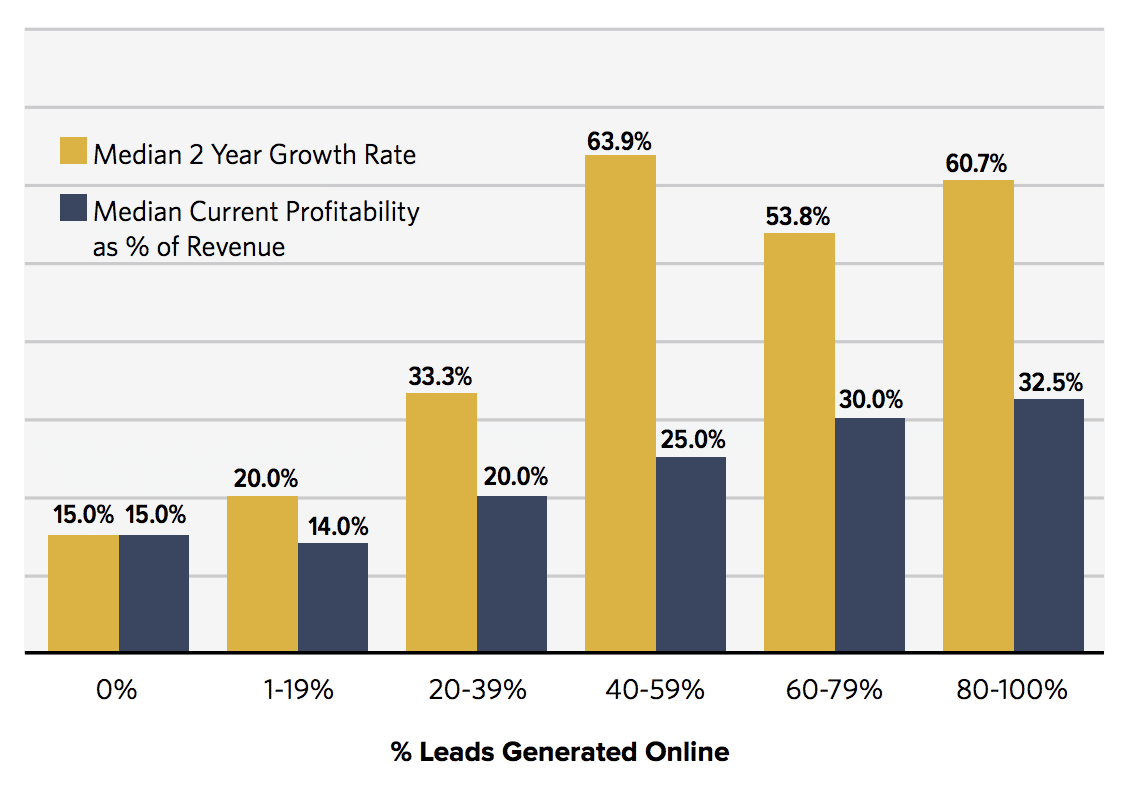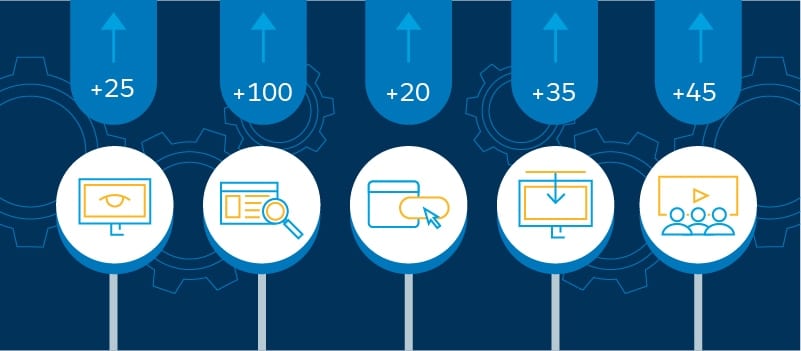Want to grow faster? Enjoy higher profits? You can achieve both goals when you learn how to run successful lead generation campaigns.
Check this out:

Data from Hinge Marketing’s Lead Generating Website Guide, shows the higher the proportion of leads generated online, the greater the firm’s profitability. And, as you see, when companies generate 40% or more of their leads online, growth rates skyrocket.
What is a Lead Generation Campaign?
A lead generation campaign is, of course, a campaign that generates leads, which means your campaign has convinced someone, somewhere, to give you their personal information (usually in the form of an email address or phone number) in exchange for something from you in return—valuable content, information, research, a free trial, a product, or something else they might want or need.
You then, in turn, now have the ability to reach out to that person again and nurture them in the hopes that they will one day become a customer.
When you’re building a lead generation campaign, you’ll need a few things—including a clear objective, a clearly defined audience, your content or offer, a budget, measurement and a nurture plan—all of which we’ll deep dive into today.
It’s easy to understand why online lead generation is key to your success. Now let’s simplify the process of creating a successful lead generation campaign by breaking it down into ten steps.
How to Create a Lead Generation Campaign
1. Establish your objective(s)

Even if every lead generation campaign is not a smashing success, every campaign is a learning experience. Welcome to the oh-so-scientific age of digital marketing where the true performers measure and monitor everything.
Do you know what you want your lead generation campaign to achieve? Establish and document one or more measurable goal. While the list of metrics that follow doesn’t cover every possibility, these common objectives should guide your choice of campaign objectives:
- A specific number of leads
- Revenue per lead
- Subscribers
- Registrants
- Trials
- Sales
- Conversion rate
- Any of the above by source
Check out these lead generation examples that map back to many of the objectives above.
2. Research your audience

Who is your lead generation campaign targeting? How specifically can you answer this?
Online shoppers… Women… Car buyers… Seniors… These aren’t great answers.
The more you can say about your prospective buyers, the more you can zero-in on their wants and needs, giving you a sharper handle when it comes to planning and executing your campaign.
Audience research is a challenge to master, but each of the following will get you started:
- Examine the demographics of your website visitors with Google Analytics
- Examine the demographics of your social followers too
- Probe the sales team for their take on who buys your products and services
- Try to ascertain what types of buyers your competitors target
- Run surveys
- Conduct customer interviews
3. Plan your content

This critical step in your lead generation campaign requires aligning the objective or objectives you’ve established and the audience you’ve targeted with the content you’ll publish.
Your content may surface on one channel, or many, including your:
- Website
- Blog
- Social media accounts
- Video and/or audio channels
- Other media where you interact with customers
Will your campaign include pay-per-click (PPC) search engine advertising? Are you also considering the longer-term play involving organic search? In both cases, keyword research is important.
For organic search, search engine optimization (SEO) is an important factor too. Consider both free and paid keyword research tools and, if you plan to put a sizable stack of chips down on either PPC or SEO, also consider seeking consultations from search engine marketing professionals.
4. Create an offer

In this step, you arrive at what’s often called a lead magnet. What will you offer? Essentially, you’ll answer the question, what do you want the person to do? The list is long and often includes:
- Download an information asset
- Register for an event
- Try a product
- Buy a product
- Enter a contest or giveaway
- Watch a video
- Subscribe to a newsletter
- Sign up for a course
- Complete a survey or assessment
- Request a demonstration
- Request a consultation
- Request a quote
- Get a coupon or discount
5. Promote your content or offer

Only in rare cases, generally on heavily trafficked websites, will an online lead generation campaign achieve its objectives without a concerted promotional effort.
Some possible channels for promotion include:
- Your own email lists
- Organic social media channels
- Blog posts
- Paid advertising in the form of:
- Social media
- Native advertising
- Search advertising
- Display advertising
- PPC campaigns
- And more.
- Guest article and PR activity
- Event activations
- And more.
Taboola is a powerful recommendation engine that powers the promotion of content, products, articles and much for advertisers on the open web. It’s a great way to boost the number of leads in your next content marketing campaign.
Review the many lead generation strategies that take advantage of the power of paid, earned and owned media. Take inspiration from this to devise a media mix that may work for your campaign.
How to Start a Discovery Campaign From Scratch
6. Optimize your lead capture mechanisms

The moment of truth for lead generation occurs when you ask a prospect to act. Will they respond to your call-to-action or leave you? In one way or the other, the pivot point becomes a form. It may ask for an email address, phone number, or credit card.
This means that the mechanisms that feature forms you put in place to capture leads —including landing pages, popups and chat — must come through for you at an acceptable rate. We take a deep dive into how to optimize your funnel here.
7. Test the components of your lead generation campaign

In the previous steps, we’ve covered the content, offers, promotional strategies and lead capture mechanisms that work together to drive your lead generation campaign.
Now, assuming your campaign continues for a reasonable period of time, you must optimize it along the way. You can do this by closely examining key metrics that reflect the efficacy of each component and run A/B split tests to compare different iterations.
Split testing is the process of testing elements of your campaign by creating variants, including email subject lines, headlines, copy, CTAs, page design, and ad targeting.
8. Perform lead scoring

Photo credit: Salesforce
Lead scoring helps your marketing and sales team focus its efforts on the leads most likely to become paying customers. Lead scoring assigns values to the quality of each lead to help sales teams identify when and how to approach the buyer.
There are a variety of lead-scoring models and ways to put them in play. A good model for getting started is to focus on criteria including:
- Fit — The degree to which the prospect fits your buyer persona(s)
- Behavior — How the prospect has interacted with your content and brand
- Buying stage — Where the prospect is in your sales funnel
9. Nurture the leads

Lead nurturing guides potential buyers through the stages of your sales funnel that lead to a sale — and beyond. ‘Beyond’ could mean increased loyalty and retention, additional purchases, and even brand advocacy.
The process of lead nurturing requires providing leads with assistance, information, content, and offers based on their current needs.
The most efficient — and often, effective — lead nurturing process involves sending highly relevant emails. It’s not easy to prescribe a perfect set of email types for every lead nurturing scenario, but think about matching leads to the content that will serve them best with:
- Welcome emails
- The delivery of offers
- Helpful problem/solution content
- Solution comparisons
- Case studies
- Making smart purchase decisions
- Getting the most from your product or service
10. Close deals

The bottom line on lead generation is there is no bottom line on lead generation. Put simply, no one feeds the family with leads. So, the final step in a successful lead generation campaign is to convert leads to sales.
If I could write you a universal prescription to close deals I’d be a very wealthy man, however, I’ll finish by emphasizing some ideas I feel are important to making lead generation campaigns the revenue-generating campaigns everyone ultimately wants.
- Look at these steps all over again with new eyes. Are you taking any of them for granted? Objectives, audience research, content marketing, offers, lead capture, testing, lead scoring and lead nurturing… They’re all important and few companies nail all nine.
- Walk in your customers shoes. This advice follows much of what we’ve talked about and the modern ‘challenger-sale’ mentality, where brands demonstrate a strong understanding of the customer’s business or life challenges, deliver helpful content, and act as a consultant or coach.
- Build trust at every step. In this age where the customer dictates the sales cycle, being helpful will amount to far greater results than being forceful.
A 10-Step Lead Generation Plan for an Effective Campaign
Building a lead generation campaign that performs well and runs smoothly is no small feat—to get there, you’ll need to follow each one of these steps:
- Establish a clear objective—how many leads do you need? What’s your cost per lead goal? In what timeframe do you need to be successful?
- Research your audience—who is the best customer for your business? Are you testing to see if you can expand this pool?
- Plan your content—does your consumer want content? a free trial? a discount or offer of some type?
- Create an offer—get creative with your content, your creatives to promote the content and more.
- Promote your content—be strategic about the channels you choose, where you’re spending your budget and where your campaign performs best.
- Optimize your lead capture—it’s paramount that you measure as you go.
- Test—if something isn’t working, try something new.
- Lead score—not all leads are created equal. Develop a mechanism so you know who is worth nurturing and following up with.
- Nurture—keep the relationship warm with the leads you know are valuable to you.
- Close deals.